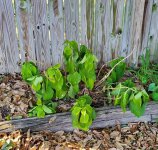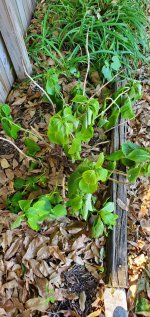Yes, it appears to be a hydrangea macrophylla or hydrangea serrata, both of which can produce mophead-form blooms (or lacecap-form blooms depending on the cultivar). Serratas tend to be smaller than macrophyllas though. It can be difficult to accurately identify these two when the specimens are young.
When temperatures typically reach or exceed around 85°F, the big leaves lose moisture faster than the roots can absorb more water so the leaves wilt and droop. You may also be insufficiently watering or watering too much. Beware of too much water as wet soil for long periods of time can also promote diseases like root rot, which produces wilting 24/7. Pest damage to the roots can also cause wilting, sometime on a single side of the plant. Windy conditions and sun exposure past 11am can also promote wilting but the plant should perk up some time after the environmental conditions improve at night... if the soil is sufficiently moist.
Maintain the soil as evenly moist as you can at a depth of 4-6" when temperatures are warm or hot; hydrangea root systems are very shallow, tiny and fibrous so dry top soil can be a problem. Maintain 3-4" of organic mulch during all months of the year to minimize soil moisture loss, protect the roots from temperature extremes, keep the weeds away and provide nourishment when the mulch decays. Water the soil only as soon as the soil feels dry when you insert a finger into the soil at a depth of 4" in several spots under the drip line. Never water the leaves if you can help it. Use enough water when watering to moisten the soil at a depth of 8" or so. Skip watering if the soil feels wet. To check for too much water, insert two fingers into the soil to retrieve a soil sample in between the fingers, at a depth of about 8"; then press on the soil to see if you observe water droplets forming. If so, the soil has too much water.
Winter protect usually after the plant has gone dormant and the foliage has dropped off. Reduce waterings when all leaves/blooms have browned out (once a week or once every two weeks depending on local rains). Stop watering the soil once temperatures are often near freezing or if the soil freezes. Resume watering when you observe leaf out and a finger inserted to a depth of 4" into the soil feels dry. Just water, mulch and protect from late frosts until your average date of last frost around 1st-2nd weeks of May. Then you can start to fertilize. Remove the winter protection as close as you can to the average date of last frost. If you remove winter protection early, be ready to cover with frost cloth/sheets and water deeply the night before frosts or before patchy frosts (these occur from freezing to 42°F).
Propagation is best done in spring from a green stem cutting with no open blooms. The percentage of success increases markedly in springen. Dormancy should start soon in St. Louis for plants in the ground/containers and all cuttings.
Propagation information:
https://plantaddicts.com/propagating-hydrangeas/
Pictures #1, 2: Stems from the previous year that do not leaf out by the end of June in St. Louis can be pruned all the way down. The chances of getting foliage at that time are very low. Avoid pruning live wood in this type of hydrangea as best as you can. The plants will develop spring flower buds inside the ends of the stems a few weeks/maybe a month after flowering but the flower buds inside the stems will not open until spring of the next year.





